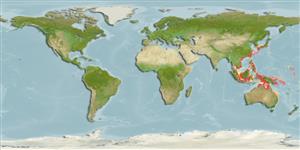Environment: milieu / climate zone / depth range / distribution range
Ökologie
seewasser demersal; tiefenbereich 30 - 40 m (Ref. 9774). Tropical
Northwest Pacific: southern Japan to the South China Sea.
Size / Gewicht / Alter
Maturity: Lm ? range ? - ? cm
Max length : 30.0 cm SL Männchen/unbestimmt; (Ref. 9774); common length : 15.0 cm SL Männchen/unbestimmt; (Ref. 9774); max. veröff. Gewicht: 169.80 g (Ref. 124479)
Rückenflossenstacheln (insgesamt) : 0; Rückenflossenweichstrahlen (insgesamt) : 78 - 82; Afterflossenstacheln: 0; Afterflossenweichstrahlen: 61 - 65; Wirbelzahl: 38. Two dark spots along gill opening below pectoral fin. Dark blotch a beginning of straight part of lateral line (Ref. 559). Soft ray count of pectoral fin refers to that on ocular side.
Inhabits muddy and sandy bottoms of the continental shelf (Ref. 9774). Feeds mainly on small demersal fishes (Ref. 9774). Marketed fresh (Ref. 9774).
Life cycle and mating behavior
Maturities | Fortpflanzung | Spawnings | Egg(s) | Fecundities | Larven
Distinct pairing (Ref. 205).
Masuda, H. and G.R. Allen, 1993. Meeresfische der Welt - Groß-Indopazifische Region. Tetra Verlag, Herrenteich, Melle. 528 p. (Ref. 9137)
IUCN Rote Liste Status (Ref. 130435)
Bedrohung für Menschen
Harmless
Nutzung durch Menschen
Fischereien: kommerziell
Tools
Zusatzinformationen
Download XML
Internet Quellen
Estimates based on models
Preferred temperature (Ref.
123201): 23.9 - 28.6, mean 28 °C (based on 95 cells).
Phylogenetic diversity index (Ref.
82804): PD
50 = 0.5000 [Uniqueness, from 0.5 = low to 2.0 = high].
Bayesian length-weight: a=0.00708 (0.00443 - 0.01132), b=3.14 (3.01 - 3.27), in cm total length, based on LWR estimates for this species & Genus-body shape (Ref.
93245).
Trophic level (Ref.
69278): 4.2 ±0.73 se; based on food items.
Widerstandsfähigkeit (Ref.
120179): hoch, Verdopplung der Population dauert weniger als 15 Monate. (Preliminary K or Fecundity.).
Fishing Vulnerability (Ref.
59153): Low to moderate vulnerability (27 of 100).
